![]() Two new forms of Pristiograptus dubius, here designated as varieties "A" and "B", are described and figured. Both were found in core samples representing the
perneri through lundgreni biozones of the Wenlock epoch. The cores are from boreholes Šiupyliai-69, Parovėja-9, Likėnai-396, Paežeriai-222 and Sutkai-87 in central and
northern Lithuania. The associated graptolites Cyrtograptus perneri Bouček, C. radians Törnquist, C. lundgreni Tullberg,
Monograptus flemingii flemingii (Salter), M. testis
testis (Barrande), Monoclimacis flumendosae (Gortani) and Pristiograptus
pseudodubius (Bouček)
(= P. parvus) are all indicative of the perneri, radians and
lundgreni biozones of the Wenlock. Two species of Pristiograptus occur in this time-stratigraphic interval: P. dubius and P. lodenicensis. In P. dubius the degree and manner of extension of the thecal apertural lip
(thecal hood) onto the succeeding theca distinguish it from otherwise very similar taxa. The thecal morphology of P. lodenicensis differs from that of a typical Pristiograptus in that the apertural lip has a central depression and is rounded into small lobes
laterally.
Two new forms of Pristiograptus dubius, here designated as varieties "A" and "B", are described and figured. Both were found in core samples representing the
perneri through lundgreni biozones of the Wenlock epoch. The cores are from boreholes Šiupyliai-69, Parovėja-9, Likėnai-396, Paežeriai-222 and Sutkai-87 in central and
northern Lithuania. The associated graptolites Cyrtograptus perneri Bouček, C. radians Törnquist, C. lundgreni Tullberg,
Monograptus flemingii flemingii (Salter), M. testis
testis (Barrande), Monoclimacis flumendosae (Gortani) and Pristiograptus
pseudodubius (Bouček)
(= P. parvus) are all indicative of the perneri, radians and
lundgreni biozones of the Wenlock. Two species of Pristiograptus occur in this time-stratigraphic interval: P. dubius and P. lodenicensis. In P. dubius the degree and manner of extension of the thecal apertural lip
(thecal hood) onto the succeeding theca distinguish it from otherwise very similar taxa. The thecal morphology of P. lodenicensis differs from that of a typical Pristiograptus in that the apertural lip has a central depression and is rounded into small lobes
laterally.
Pristiograptus; Graptoloidea; graptolite; Wenlock; Silurian; Lithuania.
Radzevičius S. (2003).- Pristiograptus (Graptoloidea) from the perneri-lundgreni biozones (Silurian) of Lithuania.- Carnets de Géologie / Notebooks on Geology, Maintenon, Article 2003/07 (CG2003_A07)
![]() Pristiograptus
(Graptoloidea) des biozones à perneri, radians et lundgreni (Silurien) de
Lithuanie.- Deux formes nouvelles de Pristiograptus dubius, appelées
ici variétés "A" et "B", sont décrites et illustrées. Toutes deux ont été
découvertes dans des échantillons de carottes dans un intervalle rapporté aux
biozones à perneri, radians et lundgreni du Wenlock. Les
carottes proviennent des forages Šiupyliai-69, Parovėja-9, Likėnai-396, Paežeriai-222
et Sutkai-87 de Lithuanie centrale et septentrionale. Les graptolites rencontrés
en association : Cyrtograptus perneri Bouček, C. radians Törnquist, C. lundgreni Tullberg, Monograptus
flemingii flemingii (Salter), M. testis testis (Barrande), Monoclimacis flumendosae (Gortani)
et Pristiograptus pseudodubius (Bouček)
(= P. parvus), sont tous caractéristiques
des biozones à perneri, radians et lundgreni du Wenlock. Deux espèces de Pristiograptus sont connues dans cet
intervalle stratigraphique : P. dubius et P. lodenicensis. Chez P. dubius
le développement (importance et morphologie) des lèvres aperturales des thèques
le long du rhabdosome permet de le distinguer d'autres taxons autrement très
voisins. La morphologie des thèques chez P. lodenicensis est distincte
de celle d'un Pristiograptus typique dans la mesure où la lèvre
aperturale présente une dépression médiane et s'arrondit latéralement en petits lobes.
Pristiograptus
(Graptoloidea) des biozones à perneri, radians et lundgreni (Silurien) de
Lithuanie.- Deux formes nouvelles de Pristiograptus dubius, appelées
ici variétés "A" et "B", sont décrites et illustrées. Toutes deux ont été
découvertes dans des échantillons de carottes dans un intervalle rapporté aux
biozones à perneri, radians et lundgreni du Wenlock. Les
carottes proviennent des forages Šiupyliai-69, Parovėja-9, Likėnai-396, Paežeriai-222
et Sutkai-87 de Lithuanie centrale et septentrionale. Les graptolites rencontrés
en association : Cyrtograptus perneri Bouček, C. radians Törnquist, C. lundgreni Tullberg, Monograptus
flemingii flemingii (Salter), M. testis testis (Barrande), Monoclimacis flumendosae (Gortani)
et Pristiograptus pseudodubius (Bouček)
(= P. parvus), sont tous caractéristiques
des biozones à perneri, radians et lundgreni du Wenlock. Deux espèces de Pristiograptus sont connues dans cet
intervalle stratigraphique : P. dubius et P. lodenicensis. Chez P. dubius
le développement (importance et morphologie) des lèvres aperturales des thèques
le long du rhabdosome permet de le distinguer d'autres taxons autrement très
voisins. La morphologie des thèques chez P. lodenicensis est distincte
de celle d'un Pristiograptus typique dans la mesure où la lèvre
aperturale présente une dépression médiane et s'arrondit latéralement en petits lobes.
![]() Pristiograptus
; Graptoloidea ; graptolite ; Wenlock ; Silurien ; Lithuanie.
Pristiograptus
; Graptoloidea ; graptolite ; Wenlock ; Silurien ; Lithuanie.
![]() In the Baltic states the graptolite genus Pristiograptus occurs throughout the
cyphus to parultimus - ultimus biozones of the Llandovery
to Pridoli. Previously, the genus has been studied only cursorily in the interval comprising the upper Sheinwoodian-lower Homerian
perneri through lundgreni biozones, probably because the index taxa for those biozones are Cyrtograptus
species, quite distinct from those used for zonation of the upper Homerian where Pristiograptus
species are the markers
(Fig. 1
In the Baltic states the graptolite genus Pristiograptus occurs throughout the
cyphus to parultimus - ultimus biozones of the Llandovery
to Pridoli. Previously, the genus has been studied only cursorily in the interval comprising the upper Sheinwoodian-lower Homerian
perneri through lundgreni biozones, probably because the index taxa for those biozones are Cyrtograptus
species, quite distinct from those used for zonation of the upper Homerian where Pristiograptus
species are the markers
(Fig. 1
![]() ). Consequently, this paper is a taxonomic review of the representatives of the genus Pristiograptus found in these
middle Wenlockian levels where it has been passed over.
). Consequently, this paper is a taxonomic review of the representatives of the genus Pristiograptus found in these
middle Wenlockian levels where it has been passed over.
![]() Pristiograptus of a dubius type dominate in the
perneri - lundgreni biozones. Pristiograptus of a new lodenicensis type appear first in the
lundgreni Biozone (see below). It has proved very difficult in the past to subdivide the dubius group
and, thus, indiscriminate identifications like
Pristiograptus
ex gr. dubius and/or P. dubius (Suess) sensu lato abound in the literature.
Pristiograptus of a dubius type dominate in the
perneri - lundgreni biozones. Pristiograptus of a new lodenicensis type appear first in the
lundgreni Biozone (see below). It has proved very difficult in the past to subdivide the dubius group
and, thus, indiscriminate identifications like
Pristiograptus
ex gr. dubius and/or P. dubius (Suess) sensu lato abound in the literature.
![]() The Pristiograptus
group was investigated in detail by Přibyl
(1943) who distinguished two 'types' based on P. dubius
and P. vulgaris
(= Colonograptus ludensis) respectively. He described 23 species of a P. dubius type and 19 of a P. vulgaris
(= Colonograptus ludensis) type ranging in age from the Late Llandovery to the
Ludlow of the Czech Republic. Urbanek
(1953, 1959, 1997) and Teller
(1964) investigated the genus in Poland. Teller
(1964) described ten species and subspecies
of the dubius group from the Ludlow, eight of which were new. Jaworowski
(1965) studied Pristiograptus from the lundgreni Biozone. He illustrated five taxa and described a new
subspecies: P. lodenicensis peribalticus. Jaeger
(1959, 1991) studied the genus in the upper Wenlock of Germany and described two new species. Some species originally described as Pristiograptus by these authors are now assigned to other recently established genera such as Colonograptus (e.g. Koren
and Urbanek, 1994; Lenz and Kozłowska-Dawidziuk,
2002) and Pseudomonoclimacis (e.g. Urbanek, 1997). Lenz and Melchin
(1991) recorded nine Pristiograptus
species as occurring in the Wenlock of Arctic Canada, and described three of them. Lenz
(2001) described only P. dubius from the lundgreni zone of Arctic Canada; he did not separate the dubius group into
other species or subspecies. Holland et alii
(1969) described the new species P. jaegeri from the upper Wenlock and lowermost Ludlow of Great Britain and Poland. Zalasiewicz and Williams (1999) recorded
the Pristiograptus group from the Wenlock of central Wales,
recognizing only one subspecies, P. dubius pseudolatus (Rickards).
The Pristiograptus
group was investigated in detail by Přibyl
(1943) who distinguished two 'types' based on P. dubius
and P. vulgaris
(= Colonograptus ludensis) respectively. He described 23 species of a P. dubius type and 19 of a P. vulgaris
(= Colonograptus ludensis) type ranging in age from the Late Llandovery to the
Ludlow of the Czech Republic. Urbanek
(1953, 1959, 1997) and Teller
(1964) investigated the genus in Poland. Teller
(1964) described ten species and subspecies
of the dubius group from the Ludlow, eight of which were new. Jaworowski
(1965) studied Pristiograptus from the lundgreni Biozone. He illustrated five taxa and described a new
subspecies: P. lodenicensis peribalticus. Jaeger
(1959, 1991) studied the genus in the upper Wenlock of Germany and described two new species. Some species originally described as Pristiograptus by these authors are now assigned to other recently established genera such as Colonograptus (e.g. Koren
and Urbanek, 1994; Lenz and Kozłowska-Dawidziuk,
2002) and Pseudomonoclimacis (e.g. Urbanek, 1997). Lenz and Melchin
(1991) recorded nine Pristiograptus
species as occurring in the Wenlock of Arctic Canada, and described three of them. Lenz
(2001) described only P. dubius from the lundgreni zone of Arctic Canada; he did not separate the dubius group into
other species or subspecies. Holland et alii
(1969) described the new species P. jaegeri from the upper Wenlock and lowermost Ludlow of Great Britain and Poland. Zalasiewicz and Williams (1999) recorded
the Pristiograptus group from the Wenlock of central Wales,
recognizing only one subspecies, P. dubius pseudolatus (Rickards).
![]() Ulst (in Gailitė et alii, 1967) worked on the graptolites of the Baltic area. She described 12 species and subspecies of Pristiograptus from the Silurian of Latvia, including one new species, P. piltenensis Koren
et Ulst
(in Gailitė et alii, 1967), from the upper Wenlock. Paškevičius
(1974, 1979) studied Pristiograptus in Lithuania and described the new species P. virbalensis from the upper Wenlock
ludensis Biozone.
Ulst (in Gailitė et alii, 1967) worked on the graptolites of the Baltic area. She described 12 species and subspecies of Pristiograptus from the Silurian of Latvia, including one new species, P. piltenensis Koren
et Ulst
(in Gailitė et alii, 1967), from the upper Wenlock. Paškevičius
(1974, 1979) studied Pristiograptus in Lithuania and described the new species P. virbalensis from the upper Wenlock
ludensis Biozone.
![]() The new Lithuanian material is from the
perneri - lundgreni biozones. Much of the material consists of specimens (some three-dimensional) chemically extracted from the rock. The Pristiograptus
discussed here are from boreholes Šiupyliai-69 (interval 1080.5-1004.8 m), Parovėja-9 (interval 619.3-545.7 m), Likėnai-396 (interval 638.5-602.9 m), Paežeriai-222 (interval 736.0-690.6 m) and Sutkai-87 (interval 821.3-803.7 m)
(Fig. 2
The new Lithuanian material is from the
perneri - lundgreni biozones. Much of the material consists of specimens (some three-dimensional) chemically extracted from the rock. The Pristiograptus
discussed here are from boreholes Šiupyliai-69 (interval 1080.5-1004.8 m), Parovėja-9 (interval 619.3-545.7 m), Likėnai-396 (interval 638.5-602.9 m), Paežeriai-222 (interval 736.0-690.6 m) and Sutkai-87 (interval 821.3-803.7 m)
(Fig. 2
![]() ). In these boreholes the maximum thickness of strata of Silurian age is 850 m. In all, about 150 samples were collected and investigated. Rhabdosomes were isolated with HCl from 50 core samples. About 300 isolated fragments of semi-flattened and 3-dimensionally preserved rhabdosomes were collected, including unusually early astogenetic stages. The associated graptolites Cyrtograptus perneri Bouček, C. radians Törnquist, C. lundgreni Tullberg,
Monograptus flemingii flemingii (Salter), M. testis testis (Barrande), Monoclimacis flumendosae (Gortani), Pristiograptus pseudodubius (Bouček)
(= P. parvus) and P. lodenicensis Přibyl
are indicative of the perneri, radians and lundgreni biozones of the Wenlock.
). In these boreholes the maximum thickness of strata of Silurian age is 850 m. In all, about 150 samples were collected and investigated. Rhabdosomes were isolated with HCl from 50 core samples. About 300 isolated fragments of semi-flattened and 3-dimensionally preserved rhabdosomes were collected, including unusually early astogenetic stages. The associated graptolites Cyrtograptus perneri Bouček, C. radians Törnquist, C. lundgreni Tullberg,
Monograptus flemingii flemingii (Salter), M. testis testis (Barrande), Monoclimacis flumendosae (Gortani), Pristiograptus pseudodubius (Bouček)
(= P. parvus) and P. lodenicensis Přibyl
are indicative of the perneri, radians and lundgreni biozones of the Wenlock.
![]() Photographs were made using the scanning electronic microscope
(SEM) in the Laboratory of the Materials Research at Tallinn Technical University (Estonia).
Photographs were made using the scanning electronic microscope
(SEM) in the Laboratory of the Materials Research at Tallinn Technical University (Estonia).
![]() The material is stored at the Department of Geology and Mineralogy of Vilnius University (Lithuania).
The material is stored at the Department of Geology and Mineralogy of Vilnius University (Lithuania).
![]() The perneri -
lundgreni biozones are located within a locally named
regional entity called the Jaagarahu Stage (Fig. 1
The perneri -
lundgreni biozones are located within a locally named
regional entity called the Jaagarahu Stage (Fig. 1
![]() ), which includes
the upper part of Riga Formation and the Birštonas, Dukstyna and Verknė formations
(Fig. 2
), which includes
the upper part of Riga Formation and the Birštonas, Dukstyna and Verknė formations
(Fig. 2
![]() ) (Lapinskas,
2000). There are no graptolites in
the Dukstyna and Verknė formations.
) (Lapinskas,
2000). There are no graptolites in
the Dukstyna and Verknė formations.
![]() The perneri Biozone is composed of dark gray argillite with rare clay limestone
interbeds in the Šiupyliai-69, Likėnai-369 and Parovėja-9 boreholes. In the
Sutkai-87 and Paežeriai-222 holes, strata representing the perneri
Biozone are gray marls with interbeds of micro-grained limestone but it is impossible to define
its boundaries accurately because graptolites are rare. Where graptolites are
present in quantity this association defines the perneri Biozone: Monograptus
flemingii flemingii (Salter), Monoclimacis flumendosae (Gortani), Cyrtograptus perneri Bouček, C. ellesae Gortani.
This biozone ranges in thickness from 29.5m (Šiupyliai-69) to 33.5m (Parovėja-9).
The perneri Biozone is composed of dark gray argillite with rare clay limestone
interbeds in the Šiupyliai-69, Likėnai-369 and Parovėja-9 boreholes. In the
Sutkai-87 and Paežeriai-222 holes, strata representing the perneri
Biozone are gray marls with interbeds of micro-grained limestone but it is impossible to define
its boundaries accurately because graptolites are rare. Where graptolites are
present in quantity this association defines the perneri Biozone: Monograptus
flemingii flemingii (Salter), Monoclimacis flumendosae (Gortani), Cyrtograptus perneri Bouček, C. ellesae Gortani.
This biozone ranges in thickness from 29.5m (Šiupyliai-69) to 33.5m (Parovėja-9).
![]() The lithology of the
radians Biozone is like that of the perneri Biozone. The
association of graptolites: Monograptus flemingii flemingii
(Salter), M. flumendosae (Gortani), Cyrtograptus radians Törnquist, C.
carruthersi Lapworth,
is indicative of the radians Biozone. Its thickness ranges between 7.5m (Šiupyliai-69)
and 10.7m (Parovėja-9).
The lithology of the
radians Biozone is like that of the perneri Biozone. The
association of graptolites: Monograptus flemingii flemingii
(Salter), M. flumendosae (Gortani), Cyrtograptus radians Törnquist, C.
carruthersi Lapworth,
is indicative of the radians Biozone. Its thickness ranges between 7.5m (Šiupyliai-69)
and 10.7m (Parovėja-9).
![]() The lithology of the
lundgreni Biozone is identical to that of the
other two. The association of graptolites that defines it is made up of two
groups. One consists of species previously recognized: Monograptus flemingii
flemingii (Salter), M. flumendosae (Gortani),
Pristiograptus pseudodubius (Bouček)
(= P. parvus) and
the other is made up of more recently recognized grouping that together with the
older group define the biozone: Eisenackograptus eisenacki (Obut et Sobolevskaya), Monograptus
flemingii compactus Elles et Wood, M. testis testis (Barrande), M.
t. inornatus Elles, Cyrtograptus lundgreni Tullberg, C. hamatus (Baily).
Its thickness ranges from 31.5m (Parovėja-9) to 50.2m (Šiupyliai-69).
The lithology of the
lundgreni Biozone is identical to that of the
other two. The association of graptolites that defines it is made up of two
groups. One consists of species previously recognized: Monograptus flemingii
flemingii (Salter), M. flumendosae (Gortani),
Pristiograptus pseudodubius (Bouček)
(= P. parvus) and
the other is made up of more recently recognized grouping that together with the
older group define the biozone: Eisenackograptus eisenacki (Obut et Sobolevskaya), Monograptus
flemingii compactus Elles et Wood, M. testis testis (Barrande), M.
t. inornatus Elles, Cyrtograptus lundgreni Tullberg, C. hamatus (Baily).
Its thickness ranges from 31.5m (Parovėja-9) to 50.2m (Šiupyliai-69).
![]() This paper employs terminology
(Fig. 3
This paper employs terminology
(Fig. 3 ![]() )
modified from Teller (1964), Urbanek
(1997) and Radzevičius and Paškevičius
(2000):
)
modified from Teller (1964), Urbanek
(1997) and Radzevičius and Paškevičius
(2000):
![]() The author is of the opinion that the thecal apertural lip
(thecal hood) may be linked to the development of the ectocortex. It is not the result of deformation because some of material is three-dimensional. The
internal structure of Pristiograptus was not studied, but will be
investigated in the future. These morphological elements should be excellent
features for discriminating between the several forms assigned to Pristiograptus
ex gr. dubius,
making their recognition easier.
The author is of the opinion that the thecal apertural lip
(thecal hood) may be linked to the development of the ectocortex. It is not the result of deformation because some of material is three-dimensional. The
internal structure of Pristiograptus was not studied, but will be
investigated in the future. These morphological elements should be excellent
features for discriminating between the several forms assigned to Pristiograptus
ex gr. dubius,
making their recognition easier.
![]() The following abbreviations are used in the descriptions below: L - length of rhabdosome including sicula; W - rhabdosome dorso-ventral width;
th1, th2, etc. - theca 1, theca 2, etc.
The following abbreviations are used in the descriptions below: L - length of rhabdosome including sicula; W - rhabdosome dorso-ventral width;
th1, th2, etc. - theca 1, theca 2, etc.
![]() Using these newly recognized morphological elements, the author describes two
forms of Pristiograptus ex gr. dubius. They may well be found to
be subspecies as material from other areas becomes available to demonstrate their
geographic extent and persistence.
Using these newly recognized morphological elements, the author describes two
forms of Pristiograptus ex gr. dubius. They may well be found to
be subspecies as material from other areas becomes available to demonstrate their
geographic extent and persistence.
Family Monograptidae Lapworth, 1873
Genus Pristiograptus Jaekel, 1889
Type species. Pristiograptus frequens Jaekel, 1889
Pristiograptus dubius group, Přibyl, 1943
Type species. Pristiograptus dubius dubius (Suess), Suess, p. 115, pl. 9, figs. 5.a-b, riccartonensis Biozone, lower Wenlock, Silurian of Vyskočilka, Male Chuchle (Czech Republic).
Diagnosis. The rhabdosome is robust. The proximal end generally has a slight ventral curvature up to th4-th6; sometimes it is straight. Thecae are uniform, cylindrical, and inclined to the rhabdosomal axis at 25-35º. There is a distinct thickening of the thecal apertural margin, the thecal apertural lip, which extends onto the lateroventral wall of the succeeding theca. The angle (ß) between the apertural margin of the theca and the succeeding thecal wall is always obtuse, especially in the more proximal thecae. The sicula is conical with a short and thin, slightly curved virgella.
Age and geographic distribution. Pristiograptus of the dubius type is widespread having been recorded from: Lithuania, Latvia, Poland, Russia, the Czech Republic, Sweden, Germany, Bulgaria, Arctic Canada, Australia, British Isles, France, Italy, Tunisia, Algeria, and Morocco, etc. The group ranges from the Upper Llandovery to the Prídolí.
Pristiograptus dubius var. "A"
Type. No S.P9-220, Fig. 5 A
![]() , Parovėja-9 borehole, depth 605.25 m, Cyrtograptus perneri Biozone.
, Parovėja-9 borehole, depth 605.25 m, Cyrtograptus perneri Biozone.
Derivation of name. Temporary designation pending additional confirmation of the ubiquity and persistence of the characteristics defining the variety.
Material. About 25 rhabdosomes and additional fragments from the Parovėja-9 borehole, depth 605.25-590.5 m.
Description. The rhabdosome is robust and straight, although some specimens show ventral curvature proximally. L is >11.5mm. The collection includes only one complete specimen
(Fig. 5 B
![]() ). The rhabdosome widens gradually from 0.8mm at
th1, to 0.9mm at th2, 1mm at th3, and 1.2mm at
th4.
Wmax is 1.7mm. The minimum W (= inter-apertural width) is 0.55mm at
th1, 0.65mm at th2, 0.85mm at th3, 0.95mm at th4,
and 1.05mm at th5. There are 5-5.5 thecae in 5mm. Thecae are cylindrical.
Th1 is 1mm long. The free part of each theca is half of its whole length. The thecal apertural lip is distinct
(Fig. 5 A-B & G
). The rhabdosome widens gradually from 0.8mm at
th1, to 0.9mm at th2, 1mm at th3, and 1.2mm at
th4.
Wmax is 1.7mm. The minimum W (= inter-apertural width) is 0.55mm at
th1, 0.65mm at th2, 0.85mm at th3, 0.95mm at th4,
and 1.05mm at th5. There are 5-5.5 thecae in 5mm. Thecae are cylindrical.
Th1 is 1mm long. The free part of each theca is half of its whole length. The thecal apertural lip is distinct
(Fig. 5 A-B & G
![]() ) and connects with that of the succeeding theca (Fig.
6 A
) and connects with that of the succeeding theca (Fig.
6 A
![]() ) except apparently in
th1 and th2 (Fig.
6 B
) except apparently in
th1 and th2 (Fig.
6 B
![]() ) although it may have been obscured in these thecae by overgrowth of cortical tissue. The apertural lip connection is particularly obvious in the medial and distal portions of the rhabdosome (Fig.
7
) although it may have been obscured in these thecae by overgrowth of cortical tissue. The apertural lip connection is particularly obvious in the medial and distal portions of the rhabdosome (Fig.
7 ![]() ). The thecae are inclined at
30º to the virgula. The sicula is short and narrow. Its L is 1.8mm and apertural W is 0.4mm. The apex of the sicula reaches the base of
th3. Th1 rises 0.1mm above the aperture. The aperture is concave in profile view. The virgella is short, up to 0.6mm long. In
one specimen there is a thickened protrusion (Fig.
5 A & G
). The thecae are inclined at
30º to the virgula. The sicula is short and narrow. Its L is 1.8mm and apertural W is 0.4mm. The apex of the sicula reaches the base of
th3. Th1 rises 0.1mm above the aperture. The aperture is concave in profile view. The virgella is short, up to 0.6mm long. In
one specimen there is a thickened protrusion (Fig.
5 A & G
![]() , 6
D
, 6
D ![]() ).
).
Comparison. Pristiograptus dubius var. "A" differs from P. pseudodubius (= P. parvus), P. dubius dubius and P. dubius var. "B" in the connection of the thecal apertural lip to the succeeding theca. In P. dubius dubius and P. dubius var. "B" the thecal apertural lip does not reach the middle of the free ventral wall of the succeeding theca and in P. pseudodubius it reaches only the middle of the free ventral wall of the succeeding theca. Also, P. dubius var. "B" differs from P. dubius var. "A" in its longer virgella - 1.35 mm, as compared with 0.6 mm. The width of P. dubius var. "B" does not exceed 1.1 mm at th4-5.
Association. P. dubius var. "A" is found with Cyrtograptus perneri (Bouček), Monograptus flemingii flemingii (Salter), Monoclimacis flumendosae (Gortani), P. pseudodubius (Bouček) (= P. parvus) and P. sp.
Age and geographical distribution. P. dubius var. "A" is widespread throughout northern Lithuania in the upper part of the Riga Formation, in the perneri Biozone of the Sheinwoodian Stage itself comprising the lower portion of a locally denominated entity, the Jaagarahu regional Stage.
Pristiograptus dubius var. "B"
Type. No. S.P222-229, fig. 8 A ![]() , Paežeriai-222 borehole, depth 730m, Cyrtograptus lundgreni Biozone.
, Paežeriai-222 borehole, depth 730m, Cyrtograptus lundgreni Biozone.
Derivation of name. Temporary designation pending additional confirmation of the ubiquity and persistence of the characteristics defining the variety.
Material. About 20 rhabdosomes and additional fragments from Paežeriai-222 borehole, depth 734.5-730m, Likėnai-396 borehole, depth 577.0-605.9m, Šiupyliai-69 borehole, depth 1007.0m.
Description. The rhabdosome is straight and narrow. L is >12.5mm. The collection includes only one complete specimen (Fig.
9 A ![]() ). W is 0.7mm at
th1, 0.75mm at th2, 0.85mm at th3, 0.95mm at th4, and 1mm at
th5.
Wmax is 1.1mm. The minimum, inter-apertural width is 0.5mm at th1, 0.6mm at
th2, 0.75mm at th3, 0.8mm at th4, and 0.9mm at
th5. There are 5-5.5 thecae in 5mm. The free part of each theca is half of its
entire length. The thecal apertural lip is distinct (Fig.
8 A-B
). W is 0.7mm at
th1, 0.75mm at th2, 0.85mm at th3, 0.95mm at th4, and 1mm at
th5.
Wmax is 1.1mm. The minimum, inter-apertural width is 0.5mm at th1, 0.6mm at
th2, 0.75mm at th3, 0.8mm at th4, and 0.9mm at
th5. There are 5-5.5 thecae in 5mm. The free part of each theca is half of its
entire length. The thecal apertural lip is distinct (Fig.
8 A-B ![]() ), extending onto the ventral wall of the succeeding theca, but not reaching
its apertural lip (Fig. 9 A
), extending onto the ventral wall of the succeeding theca, but not reaching
its apertural lip (Fig. 9 A ![]() ),
but ending midway up the ventral wall (Fig.
9 C
),
but ending midway up the ventral wall (Fig.
9 C ![]() ). Thecae are inclined at
30º to the virgula. The sicula is 2mm long and its apertural width is 0.35mm. The apex of sicula is at approximately the level of the apertural lip of
th2. Th1 arises 0.2mm above the sicular aperture. The virgella is long (1.35 mm) and narrow (Fig.
9 D
). Thecae are inclined at
30º to the virgula. The sicula is 2mm long and its apertural width is 0.35mm. The apex of sicula is at approximately the level of the apertural lip of
th2. Th1 arises 0.2mm above the sicular aperture. The virgella is long (1.35 mm) and narrow (Fig.
9 D ![]() ).
).
Comparison. See under Pristiograptus dubius var. "A".
Association. Pristiograptus dubius var. "B" is found with Monograptus flemingii flemingii (Salter), M. f. compactus Elles et Wood, M. testis testis (Barrande), M. t. inornatus Elles, Pristiograptus pseudodubius (Bouček) (= P. parvus), Monoclimacis flumendosae (Gortani), Cyrtograptus lundgreni Tullberg, Paraplectograptus tenuis (Eisenack) and Eisenackograptus eisenacki (Obut et Sobolevskaya).
Age and geographic distribution. Pristiograptus dubius var. "B" is widespread throughout central and western Lithuania. It is found in the lundgreni Biozone of the Lower Homerian Stage within the Jaagarahu regional Stage which spans the upper part of the Riga Formation and the overlying Birštonas Formation.
Pristiograptus sp.
Fig. 10 A-E ![]()
Material. One specimen, no S.P9-219, from the Parovėja-9 borehole, depth 595.4m; rhabdosome with th1-8.
Description. The rhabdosome is straight, massive. L is >11.1mm. The rhabdosome widens gradually. W is 0.8mm at
th1, 1mm at th2, 1.1mm at th3, 1.3mm at th4,
and 1.4mm at th5.
Wmax is 1.6mm. The interapertural width is 0.57mm at th1, 0.68mm at
th2, 0.73mm at th3, 0.91mm at th4, and 0.91mm at
th5. There are 5-5.5 cylindrical thecae in 5mm. Th1 is 1.6mm long. The free portion of each theca is equal to half of its length. The thecal apertural lip is distinct (Fig.
10 B ![]() ), extending over the free part of the succeeding theca and connecting with its apertural lip (Fig.
10 A
), extending over the free part of the succeeding theca and connecting with its apertural lip (Fig.
10 A ![]() ). This connection is easily discernible in the
medial and distal parts of the rhabdosome. Th1 and th2 either do not have such thecal apertural lip connections or they are covered by cortical tissue (Fig.
10 D
). This connection is easily discernible in the
medial and distal parts of the rhabdosome. Th1 and th2 either do not have such thecal apertural lip connections or they are covered by cortical tissue (Fig.
10 D ![]() ). The thecal apertural lip bifurcates (Fig.
10 D
). The thecal apertural lip bifurcates (Fig.
10 D ![]() ) a feature well developed in the distal part of the rhabdosome. An intergrowth arch is well developed especially in the proximal part of the rhabdosome (Fig.
10 C
) a feature well developed in the distal part of the rhabdosome. An intergrowth arch is well developed especially in the proximal part of the rhabdosome (Fig.
10 C ![]() ). The distance between the thecal apertural lip connection on the succeeding theca and the origin of its bifurcation is 0.25mm for
th1 and th2, and 0.35mm for th3-5. Thecae are inclined at
30º to the virgula. The sicula is short and narrow, 2mm long with an apertural width of 0.4mm. The apex of the sicula reaches the base of the
th2/th3 interthecal septum. Th1 arises 0.15mm above the sicular aperture. The sicular aperture is strongly concave in profile view (Fig.
10 E
). The distance between the thecal apertural lip connection on the succeeding theca and the origin of its bifurcation is 0.25mm for
th1 and th2, and 0.35mm for th3-5. Thecae are inclined at
30º to the virgula. The sicula is short and narrow, 2mm long with an apertural width of 0.4mm. The apex of the sicula reaches the base of the
th2/th3 interthecal septum. Th1 arises 0.15mm above the sicular aperture. The sicular aperture is strongly concave in profile view (Fig.
10 E ![]() ). The virgella is thick and short (Fig.
10 E
). The virgella is thick and short (Fig.
10 E ![]() ), 0.74mm long.
), 0.74mm long.
Comparison. Pristiograptus sp. differs from P. pseudodubius (= P. parvus), P. dubius dubius, and Pristiograptus dubius var. "A" in the length and form of the thecal apertural lip in its connection with the succeeding thecal apertural lip. The thecal apertural lip of Pristiograptus sp. extends over the free part of the succeeding theca and connects with its apertural lip. In P. dubius dubius and P. dubius var. "B" the extension of the thecal apertural lip does not attain the middle of the free part of the succeeding theca. In P. pseudodubius the extension reaches the middle of the free portion of the succeeding theca. P. sp. differs from P. dubius var. "A" in that the thecal apertural lip bifurcates in the middle of the free part of the succeeding theca. P. dubius var. "A" lacks such a bifurcation.
Association. Pristiograptus sp. is found with Cyrtograptus perneri (Bouček), Monograptus flemingii flemingii (Salter), Monoclimacis flumendosae (Gortani), Pristiograptus pseudodubius (Bouček) (= P. parvus), and P. dubius var. "A".
Age and geographic distribution. Pristiograptus sp. is recorded only from the Parovėja-9 borehole, northern Lithuania, in the perneri Biozone of the Sheinwoodian Stage.
![]() Pristiograptus lodenicensis was investigated by Radzevičius and Paškevičius
(2000). The
data in the accompanying table are unchanged from that presentation. But new pictures and photos improve
the appreciation of their significance.
Pristiograptus lodenicensis was investigated by Radzevičius and Paškevičius
(2000). The
data in the accompanying table are unchanged from that presentation. But new pictures and photos improve
the appreciation of their significance.
Pristiograptus lodenicensis group, Radzevičius et Paškevičius, 2000
Type species. Pristiograptus lodenicensis Přibyl, Přibyl, 1943, p. 21, pl. 1, figs. 4 & 6, Cyrtograptus lundgreni Biozone, Wenlock, Silurian of Lodenice-Budovice (Czech Republic).
Diagnosis. The rhabdosome is massive. The proximal end is straight or ventrally curved up to th4 or th5. Thecae are uniform and widen towards their apertures, which show small depressions centrally. Thecal apertures are perpendicular to the rhabdosomal axis. The sicula is small and conical with a slender, short virgella.
Remarks. All species not belonging to the dubius group, including P. lodenicensis, were previously assigned to the vulgaris group (Přibyl, 1943). Subsequently, P. vulgaris (Wood) was synonymised with P. ludensis (Murchison), so this group must be renamed. The taxonomic position of the lodenicensis group is not clear because P. lodenicensis is not a typical Pristiograptus. The thecae are similar to those of Colonograptus (e.g. Colonograptus gerhardi (Kühne)), differing only in the lesser curvature of the lip of the thecal aperture, as is also the case with Pseudomonoclimacis (e.g. Pseudomonoclimacis latilobus (Tsegelniuk)) and Monograptus massai Jaeger, the latter recorded from the Ludlow of NW Libya. This Libyan species can be assigned the lodenicensis group as it possesses a typical Pristiograptus sicula.
Age and geographic distribution. The lodenicensis group is known from the lundgreni Biozone of Lithuania, Latvia, the Czech Republic and Poland.
Pristiograptus lodenicensis Přibyl (1943)
Holotype. Pristiograptus lodenicensis Přibyl, 1943. Plate I, fig. 2. Upper Wenlock (Homerian stage), Cyrtograptus lundgreni Biozone.
Material. About 50 rhabdosomes and fragments from the Kurtuvenai-161, Likėnai-396 and Parovėja-9 boreholes. Some specimens from Parovėja-9 were chemically prepared.
Description. The rhabdosome is straight, massive; the proximal end of some specimens is slightly curved ventrally as far as
th4 or th5. L is at least 30mm. W is 0.7mm at th1, 0.8mm at
th2, 0.9mm at th3, 1mm at th4, and 1.2 mm at th5.
Wmax is normally 1.5mm but may reach 2mm by th16-18. The inter-apertural width is 0.55mm at
th1, 0.6mm at th2, 0.7mm at th3, 0.85mm at th4, and 0.9mm at
th5. Thecae are uniform, slightly curved, and widen towards the aperture. The apertural lips of symmetrically flattened thecae form an acute angle (ß) with the succeeding thecae. Thecae of specimens possessing relief are slightly different. They are slightly curved, widening towards the aperture, which shows (Fig. 11 ![]() ) a small ventral depression and curvature at the connection with the succeeding theca (Fig.
12 B & D-E
) a small ventral depression and curvature at the connection with the succeeding theca (Fig.
12 B & D-E ![]() ). Overall, thecal apertures are perpendicular to the rhabdosomal axis.
Th1 is 0.9-1mm long, and overlaps for 1/3-1/2 of its length. Thecae are inclined to the rhabdosomal axis at an angle
29-32º. The sicula is small, 1.2-1.5mm long, and 0.25-0.3mm wide aperturally (Fig.
12 F
). Overall, thecal apertures are perpendicular to the rhabdosomal axis.
Th1 is 0.9-1mm long, and overlaps for 1/3-1/2 of its length. Thecae are inclined to the rhabdosomal axis at an angle
29-32º. The sicula is small, 1.2-1.5mm long, and 0.25-0.3mm wide aperturally (Fig.
12 F ![]() ). It is slightly
curved ventrally. The sicular apex attains a level between the middle and the top of
th2.
). It is slightly
curved ventrally. The sicular apex attains a level between the middle and the top of
th2.
Comparison. P. lodenicensis differs from all dubius types of Pristiograptus in the existence of a depression in the central part of the aperture and in the angle of the aperture that overall is perpendicular to the rhabdosomal axis, whereas in the dubius group this angle (ß) is always obtuse. The thecae of P. lodenicensis are conical while those of the dubius group are cylindrical. The thecae of P. virbalensis are square in cross-section. P. lodenicensis differs from P. deubeli in the greater curvature of the thecal apertures and in P. deubeli only the apertures of th1-th4 are curved.
Association. P. lodenicensis is found with Monograptus flemingii flemingii (Salter), M. f. compactus Elles et Wood, M. testis testis (Barrande), M. t. inornatus Elles, Pristiograptus pseudodubius (Bouček) (= P. parvus), Monoclimacis flumendosae (Gortani), Cyrtograptus lundgreni Tullberg, Paraplectograptus tenuis (Eisenack) and Eisenackograptus eisenacki (Obut et Sobolevskaya).
Age and geographic distribution. P. lodenicensis is widespread in the East Baltic area: (Lithuania, Latvia). It is found in the upper part of Riga Formation and in the Birštonas Formation, in the lundgreni Biozone of the Homerian Stage, Jaagarahu regional Stage. P. lodenicensis is also found in the Czech Republic, and Poland.
Acknowledgements
![]() I am grateful to Juozas Paškevičius for providing the material and to
Petras Musteikis for reading the manuscript and for critical remarks. I thank
Jan Zalasiewicz, David Loydell,
Alfred Lenz,
Philippe Legrand and an "anonymous reviewer" for helpful suggestions, corrections and improvements. I am obliged to
Jurga Stasevičiute, David Loydell and Nestor Sander for improvements in the English of the presentation.
I am grateful to Juozas Paškevičius for providing the material and to
Petras Musteikis for reading the manuscript and for critical remarks. I thank
Jan Zalasiewicz, David Loydell,
Alfred Lenz,
Philippe Legrand and an "anonymous reviewer" for helpful suggestions, corrections and improvements. I am obliged to
Jurga Stasevičiute, David Loydell and Nestor Sander for improvements in the English of the presentation.
Gailitė L., Rybnikova M., Ulst R. (1967).- Stratigraphy, fauna and formation conditions of Silurian rock in the Middle Baltic State [In Russian].- Izdatel'stvo Zinatne, Riga, 304 p.
Holland C.H., Rickards R.B., Warren P.T. (1969).- The Wenlock graptolites of the Ludlow district, Shropshire and their stratigraphical significance.- Palaeontology, London, Vol. 12, Part 4, pp. 663-683.
Jaeger H. (1959).- Graptolithen und Stratigraphie des jüngsten Thüringer Silurs.- Abhandlungen der Deutschen Akademie der Wissenschaften zu Berlin, Berlin, Klasse für Chemie, Geologie und Biologie, Jahrgang 1959, Nr. 2, 197 p.
Jaeger H. (1991).- Neue Standard-Graptolithenzonenfolge nach der "Grossen Krise" an der Wenlock/Ludlow Grenze (Silur).- Neue Jahrbuch für Geologie und Paläeontologie, Abhandlungen, Stuttgart, 182 (3), pp. 303-354.
Jaworowski K. (1965).- Strop warstw posłeckich w obniženiu litewskim a granica wenlock-ludlow.- Kwartalnik Geologiczny, Warsaw, 9 (3), pp. 511-527.
Koren T.N., Urbanek A. (1994).- Adaptative radiation of monograptids after the Late Wenlock crisis.- Acta Palaeontologica Polonica, Warsaw, Vol. 39, No. 2, pp. 137-167.
Lapinskas P. (2000).- Structure and petroliferosity of the Silurian in Lithuania.- Institute of Geology, Vilnius, 203 p.
Lenz A.C., Kozłowska-Dawidziuk A. (2001).- Late Wenlock (Silurian) graptolites of Arctic Canada: pre-extinction, lundgreni Biozone fauna.- Palaeontolographica Canadiana, St. John's, Nº 20, 61 p.
Lenz A.C., Kozłowska-Dawidziuk A. (2002).- Upper Homerian (Upper Wenlock, Silurian) graptolites from Arctic Canada.- Journal of Paleontology, Tulsa, 76, pp. 321-346.
Lenz A.C., Melchin M.J. (1990).- Wenlock (Silurian) graptolites, Cape Philips Formation, Canadian Arctic Island.- Canadian Journal of Earth Sciences, Ottawa, 27, pp. 1-13.
Lenz A.C., Melchin M.J. (1991).- Wenlock (Silurian) graptolites, Cape Philips Formation, Canadian Arctic Islands.- Transactions of the Royal Society of Edinburgh: Earth Sciences, Edinburgh, 82, pp. 211-237.
Münch A. (1952).- Die Graptolithen aus dem anstehenden Gotlandium Deutschlands und der Tschechoslowakei.- Geologica, Berlin, 7, pp. 18-157.
Paškevičius J. (1974).- Graptolites and zonal dismemberment of Ludlow deposits in Baltic State.- In: Obut A. (Ed.), Graptolity SSSR.- Nauka, Novosibirsk, pp. 122-134.
Paškevičius J. (1979).- Biostratigraphy and graptolites of the Lithuanian Silurian.- Mokslas, Vilnius, 267 p.
Přibyl A. (1943a).- O nekolika novych graptolitech z českeho a nemeckeho siluru (Gotlandienu).- Věstník Královské České Společnosti Nauk, Praha, třída matemat.-přírodověd., Ročník 1943, 4 p.
Přibyl A. (1943b).- Revise zastupcu rodu Pristiograptus ze skupiny P. dubius a P. vulgaris z českeho a ciziho siluru.- Rozpravy II. tř. České akad., Praha, Ročník LIII, pp. 1-40.
Radzevičius S., Paškevičius J. (2000).- Pristiograptids (Graptolites) and their adaptive types of the Wenlock (Silurian) in Lithuania.- Geologija, Vilnius, 32, pp. 88-109.
Suess E. (1851).- Über böhmische Graptolithen.- Naturwissenschaftliche Abhandlungen von Haidinger, Wien, Bd. IV, Abth. IV, p. 87-134.
Szymanski B., Teller L. (1998).- The Silurian stratigraphy of the Zawierce-Zarki area (NE margin of the Upper Silesian Coal Basin).- Geological Quarterly - Kwartalnik Geologiczny, Warsaw, 42 (2), pp. 183-200.
Teller L. (1964).- Graptolite fauna and stratigraphy of the Ludlovian deposits of the Chelm-borehole, Eastern Poland.- Studia Geologica Polonica, Warsaw, 13, pp. 36-38.
Tsegelniuk (1976).- Late Silurian and Early Devonian monograptids from the south-western margin of the East Europe platform.- In: Shulgat P.L. (Ed.), Palaeontology and stratigraphy of the Upper Precambrian and Lower Paleozoic of the SW part of the East European platform.- Naukova Dumka, Kiev, pp. 91-133.
Ulst R. (1974).- The early sequence of Pristiograptids in conterminous deposits of Wenlock and Ludlow of the Middle Prebaltic.- In: Obut A. (Ed.), Graptolity SSSR.- Nauka, Novosibirsk, pp. 90-105.
Urbanek A. (1953).- O dwoch gatunkach Monograptidae. Acta Palaeontologica Polonica, Warsaw, Vol. 3, pp. 277-297.
Urbanek A. (1959).- Studies on graptolites I. Development and structure. Pristiograptus gotlandicus (Perner).- Acta Palaeontologica Polonica, Warsaw, Vol. 4, No. 1, pp. 11-26.
Urbanek A. (1963).- On generation and regeneration of cladia in some Upper Silurian monograptids.- Acta Palaeontologica Polonica, Warsaw, Vol. 8, No. 2, pp. 135-254.
Urbanek A. (1997).- Late Ludfordian and early Pridoli monograptids from the Polish Lowland.- Paleontologia Polonica, Warsaw, Vol. 56, pp. 157-159.
Zalasiewicz J., Williams M. (1999).- Graptolite biozonation of the Wenlock series (Silurian) of the Builth Wells district, central Wales.- Geological Magazine, London, 136 (3), pp. 263-283.

Click on thumbnail to enlarge the image.
Figure 1: Correlation of Lithuanian graptolite biozones with those of Arctic Canada (Lenz and Melchin, 1991; Lenz and Kozłowska-Dawidziuk, 2002); with those of Poland (Szymanski and Teller, 1998; Lenz and Kozłowska-Dawidziuk, 2002) and with those of Central Wales (Zalasiewicz and Williams, 1999).
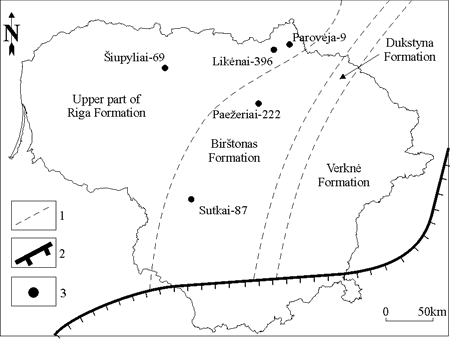
Click on thumbnail to enlarge the image.
Figure 2: The extent of the Jaagarahu regional Stage (Lapinskas, 2000) and location of the boreholes involved. 1) formational boundaries; 2) south of this line Silurian rocks were removed by later erosion; 3) location of boreholes.

Click on thumbnail to enlarge the image.
Figure 3:
Morphological elements of a Pristiograptus rhabdosome: th1 - the first theca, ß - angle between thecal aperture and succeeding theca;
![]() - angle between thecal axis and
virgula.
- angle between thecal axis and
virgula.

Click on thumbnail to enlarge the image.
Figure 4: The forms of thecal apertural lip: A-C Pristiograptus of a dubius type; A - P. pseudodubius (= P. parvus): the thecal apertural lip terminates in the middle part of the succeeding theca (tal); B - P. dubius var. "A": the thecal apertural lip joins the apertural lip of the succeeding theca (tal); C - Pristiograptus sp., the apertural lip of a theca joins the apertural lip of the succeeding theca (tal) and bifurcates to produce an intergrowth arch (ia); D - Monoclimacis sp., the apertural lip of the theca forms an apertural hood (tal); E - P. lodenicensis, the thecal apertural lip has a small central depression (dep); F - Pseudomonoclimacis labiatus (Urbanek, 1997) the thecal apertural lip has a large central depression.
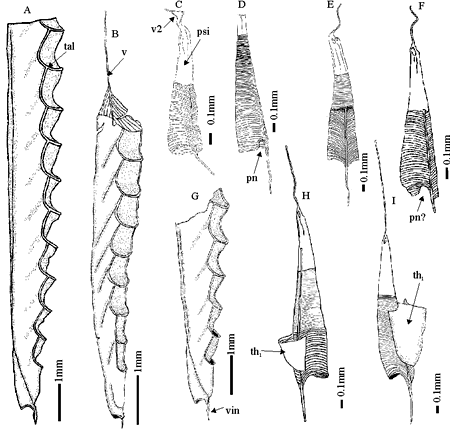
Click on thumbnail to enlarge the image.
Figure 5: A-I Pristiograptus dubius var. "A", Parovėja-9 borehole, depth 605.25-602.9m; A - S.P9-220, type, showing the thecal apertural lip connecting with that of the succeeding theca (tal); B - S.P9-223, with long virgula (v); C - S.P9-215a, prosicula (psi) and double, juvenile, virgula (v2); D - S.P9-215b, sicula showing the open primary notch (pn); E - S.P9-215c, sicula; F - S.P9-215d, sicula with possible open primary notch (pn?); G - S.P9-214, small protrusion in the middle part of virgella (vin); H - S.P9-215e, sicula with th1; I - S.P9-215f, sicula with th1.
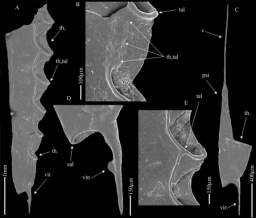
Click on thumbnail to enlarge the image.
Figure 6: A-C Pristiograptus dubius var. "A", Parovėja-9 borehole, depth 605.25m; A-B & D-E - S.P9-214, A - proximal end: view of rhabdosome, virgella (vir), th1 (th1), thecal apertural lip of th4 (th4tal), th5 (th5); B - th1 and th2, note unclear apertural lip of the first theca on the second theca (th1tal); D - the virgella with a small protrusion in the middle (vin) and the lip of the sicular aperture (sal); E - thecal apertural lip of th4 joining that of th5 (tal); C - S.P9-215e, sicula with virgula (v), prosicula (psi), virgella (vir) and th1 (th1).
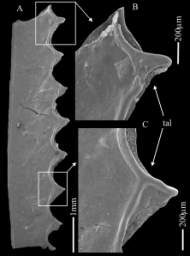
Click on thumbnail to enlarge the image.
Figure 7: A-C Pristiograptus dubius var. "A", Parovėja-9 borehole, depth 605.25m, S.P9-214a; A - general view of medial part of rhabdosome; B-C - connection of thecal apertural lip to the apertural lip of the succeeding theca (tal).
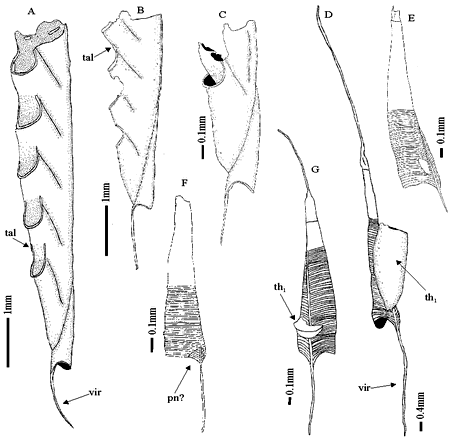
Click on thumbnail to enlarge the image.
Figure 8: A-G Pristiograptus dubius var. "B". A - S.P222-229, type, virgella (vir), the end of the thecal apertural lip (tal), Paeeriai-222 borehole, depth 730m; B - S.L396-218a, proximal part of rhabdosome with the end of the thecal apertural lip (tal), Likėnai-396 borehole, depth 605.9m; C - S.S69-228a, sicula with th1 and th2, iupyliai-69 borehole, depth 1007m; D - S.P222-217a, sicula with long virgella (vir) and th1, Paeeriai-222 borehole, depth 734.5m; E - S.L396-231a, sicula, Likėnai-396 borehole, depth 577m; F - S.P222-230a, sicula with possible open primary notch (pn?), Paeeriai-222 borehole, depth 730m; G - S.L396-231b, sicula with incomplete th1, Likėnai-396 borehole, depth 577m.
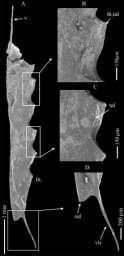
Click on thumbnail to enlarge the image.
Figure 9: A-D Pristiograptus dubius var. "B", P.P222-216, Paeeriai-222 borehole, depth 734.5m. A - general view of proximal portion of a rhabdosome with virgula (v) and th1 (th1); B - apertural lip of th5 (th5tal); C - end of the thecal apertural lip of th2 (tal); D - sicular aperture with dorsal lip (sal) and long virgella (vir).
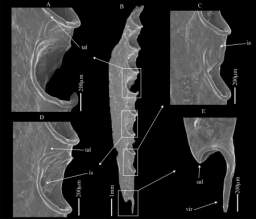
Click on thumbnail to enlarge the image.
Figure 10: Pristiograptus sp., Parovėja-9 borehole, depth 595.4m, S.P9-219; A - thecal apertural lip joins succeeding theca's apertural lip (tal); B - proximal part of rhabdosome; C - intergrowth arch of th1 (ia); D - intergrowth arch of th3, interthecal septum (is) and unclear thecal apertural lip on succeeding theca (tal); E - thick virgella (vir) and sicular apertural lip (sal).
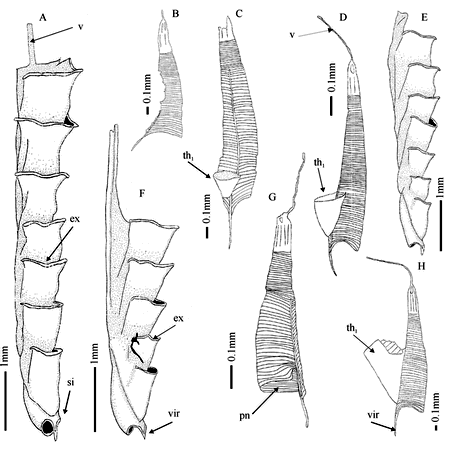
Click on thumbnail to enlarge the image.
Figure 11: Pristiograptus lodenicensis Přibyl, all specimens from the Parovėja-9 borehole, A - P.P9-5, rhabdosome with virgula (v) and sicula (si); there is a small depression of the thecal apertural lip of th3 (ex), depth 558.3m; B - P.P9-208a, sicula, depth 5583m; C - P.P9-202a, sicula with beginning of th1 (th1), depth 547.7m; D - P.P9-202b, sicula with incomplete th1 (th1) and virgula (v), depth 547.7m; E - P.P9-6, proximal part of rhabdosome, depth 561.9m; F - P.P9-1, th1-th5, with a small depression on the apertural lip of th2 (ex) and a virgella (vir), depth 561.9 m; G - P.P9-208b; sicula with open primary notch (pn), depth 558.3m; H - P.P9-208c sicula, virgella (vir) and th1 (th1), depth 558.3m.
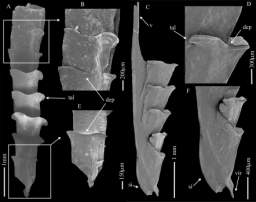
Click on thumbnail to enlarge the image.
Figure 12: A-F Pristiograptus lodenicensis Přibyl, A-B & E - S.P9-211a, depth 558.3m, medial part of rhabdosome with thecal apertural lip (tal); B & E - depression of thecal apertural lip (ex); C-D & F - P.P9-1, depth 561.9m; C - th1-th5 with sicula (si) and virgula (v); D - thecal apertural lip of th3 (tal) and its depression (ex); F - th1-th2, with sicula (si) and virgella (vir).